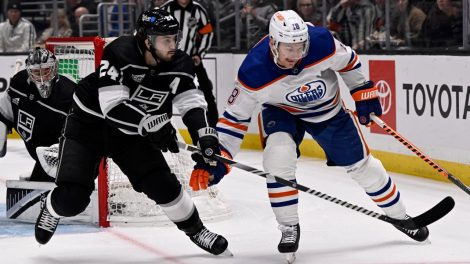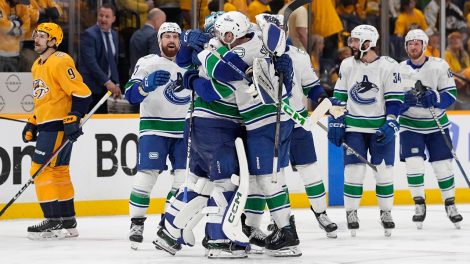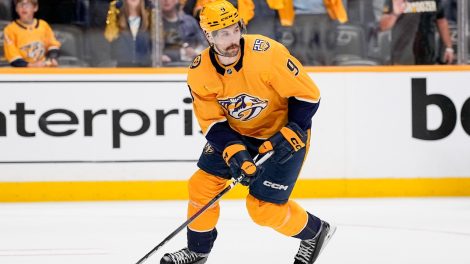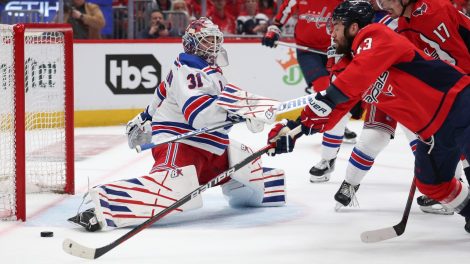The Vancouver Canucks made a titanic splash in free agency a year ago, signing winger Loui Eriksson to a six-year, $36-million contract, then spent the winter wet and shivering. General manager Jim Benning might have succumbed to hypothermia, but survived the Canucks’ 29th-place finish.
That first $6 million instalment bought 11 goals from Eriksson, who put a puck into his own net on a delayed penalty in his Canucks’ debut, didn’t score FOR his new team until Game 14 and had his worst season since 2007 end with a knee injury on March 5.
Other than that, Eriksson was terrific.
Actually, he did post positive possession numbers and, given his history and a career shooting percentage of 13.4 per cent (last season it was 8.3 per cent), Eriksson should bounce back. In his first of three seasons in Boston, where Benning in his previous job pushed hard for Eriksson’s acquisition, the forward also struggled to score and stay healthy.
But Eriksson was progressively better each of the next two years.
Still, it’s doubtful he’ll produce like a $6-million-a-year player for the Canucks, and even more doubtful that Benning will pledge that kind of salary to any unrestricted free agent this summer – or any other summer in the next few years.
The Canucks will be buying when free agency opens on July 1, but they’ll likely be shopping at Walmart, looking for low-cost players to bolster organizational depth and help in a couple of specific areas.
The surprising return to Russia and sacrifice of millions in future income by defenceman Nikita Tryamkin, whose departure at least helped cool the Vancouver housing market, and the expected expansion-draft loss of Luca Sbisa has created a short-term need for another experienced blueliner.
But Benning won’t be offering to any UFA anything like $6 million in salary or six years in term. And he may not add any defencemen because the Canucks will give 2016 fifth-overall pick Olli Juolevi the chance to make the team next fall as a 19-year-old, and have already signed Swedish League free agent Philip Holm in the belief the 25-year-old may be ready for the National Hockey League.
Sure, the Canucks need an experienced goalie to share the net with Jacob Markstrom while uber-prospect Thatcher Demko develops in the American League. But that goalie could be their own starter, Ryan Miller, who becomes a UFA on July 1 and may accept for family reasons a short-term deal to stay in Vancouver.
So don’t expect any more cannonballs by Benning into the deep end of the free-agent pool.
“That’s not our objective,” he said. “We have now some young players knocking on the door looking for jobs, so we’re not going to be in on the high-end (free agents). Who knows? But we’re not looking to do that at the start.
“If these young players come to camp and earn a spot on the team, we want to make sure there’s room for them to play and keep developing. With the injuries we’ve had to our group the last couple of years, we want to add to our depth. When I say that, I mean complementary players.”
The Canucks have nearly $19.5 million in available salary-cap space, but more than half of that could be eaten up by new deals for Miller and leading scorer Bo Horvat, the restricted free agent who in his third NHL season burst through what many people thought was his offensive ceiling. Horvat could make $6-million-a-year on his next contract.
Partway through a rebuild that has seen Benning accumulate a small handful of promising young players, the Canucks also have to protect cap space long-term for guys like Sven Baertschi, Markus Granlund, Troy Stecher and Brock Boeser, a 23rd overall pick from the 2015 draft who jumped straight to the Canucks from the University of North Dakota last spring and scored four times in nine games.
“We weren’t planning on losing Tryamkin,” Benning said of the 6-foot-7, 22-year-old. “That was a tough loss; I’m not going to lie. We spent a third-round pick drafting him, and it’s hard to get Russian players to sign and come over here. I thought over the course of the year he showed why we drafted him – that he could develop into a matchup, top-pair guy at some point. So for him to leave at the end of the year and sign back in Russia, it was hard. But that’s the risk you take with players from Russia. Sbisa, we knew that could happen, so we were planning for that.
“Three months ago, defence was a position from an organization standpoint we felt we had depth at. And now we’ve lost some of that depth.”
Years from now, if the Canucks don’t soon emerge from their first prolonged down-cycle since the 1990s, people will still be talking about losing Tryamkin. And getting Eriksson.
SALARY CAP BREAKDOWN
Forwards: $32.3 million
Defence: $17.425 million
Goaltenders: $3.667 million
Retained salary/buyouts: $2.133 million
Total: $55.525 million ($19.475 available cap space)
AREAS OF NEED
Puck-moving defenceman: The Canucks’ defence was thinned by the expansion-draft loss of Sbisa and the surprise defection back to Russia and the KHL of promising prospect Tryamkin. Fifth-overall pick Juolevi or Swedish League free agent Holm may make the Canucks next fall, but the team could still use another experienced blueliner for the next two-to-three years.
A goalie capable of 40 starts: The team is trying hard to re-sign Miller, its 37-year-old starter. But the Canucks want him on a one-year deal because backup Jacob Markstrom is ready to play more and being paid to play more (three-year, $11-million extension kicks in next season).
Minor-league depth: The Canucks were so needy for help last season, Jayson Megna and Michael Chaput spent most of the year in the NHL instead of the AHL. With winger Boeser expected to stick in the NHL after leaving college last spring, the Canucks have little to fall back on in the minors if injuries hit again.
POTENTIAL TARGETS
Ryan Miller: The goalie cost the Canucks $18 million over three years when Benning made Miller his first big free-agent signing in 2014. The American Olympian had three good, if unspectacular, seasons and remains a solid middle-tier NHL starter. The problem is he turns 37 in July and may be able to command a deal longer than the one-year one the Canucks are offering while Markstrom gets a bigger share of the net and goalie-of-the-future Demko develops in the AHL. If the Canucks can’t get Miller, other goalies out there include Brian Elliott, Jonathan Bernier and Chad Johnson.
Trevor Daley: The 33-year-old never lived up to projections as an offensive defenceman, but he has experience, a couple of Stanley Cup rings and still skates well enough to retrieve pucks and move them forward in a supporting role. He may also come just cheaply enough for the Canucks, who could use a “bridge” defenceman to help them the next couple of years while younger blueliners develop.
Kenny Agostino: The Canucks need to bolster their scoring depth everywhere, including in the AHL, and Agostino is the highest-scoring minor-league UFA available. The 25-year-old playmaking winger led the AHL with 83 points in 65 games with the Chicago Wolves last season, and didn’t look entirely out of place in the NHL during seven games with the Blues. Agostino will be pricey as minor-leaguers go, but Benning has demonstrated a willingness to pay for the security of good AHL players.
RECENT FREE AGENT ACQUISITIONS
Loui Eriksson, $36 million/6 years in 2016: GM Benning wanted Milan Lucic but appeared to land a golden consolation prize in free agency when he signed Eriksson after the Swede’s 30-goal season in Boston. Then the winger went 14 games before scoring as a Canuck and finished the season with just 11 goals and 24 points in 65 games. The good news – yes, there is some – is that Eriksson posted positive possession numbers and, at 32, is still young enough to help the team while the next wave develops. But that’s an awfully expensive bridge.
Jayson Megna and Michael Chaput, each $600,000/1 year in 2016: The Canucks signed these forwards for organizational depth. But injuries and roster erosion allowed them to play in Vancouver and they combined for 126 NHL games. Each scored four goals. They were sometimes ridiculed by critics for poor stats, traditional and advanced, and because their presence in the lineup was viewed as an indictment of Benning’s management. But they never cheated anyone, and the speedy Megna was quickly re-signed to another one-year, one-way deal. Chaput is an RFA.
Matt Bartkowski, $1.75 million/1 year in 2015: Bartkowski was a low-cost (relatively) gamble by Benning, who knew the player from their time in Boston and believed Bartkowski could develop into a top-four defenceman if given the chance. Bartkowski played in 80 games, but contributed just 18 points, was a minus-19 and posted a Corsi-for of just 45.9 per cent. Unwanted in the NHL at the start of this past season, he signed a minor-league contract before the Calgary Flames rescued him in February with a two-year, two-way deal.
[relatedlinks]









